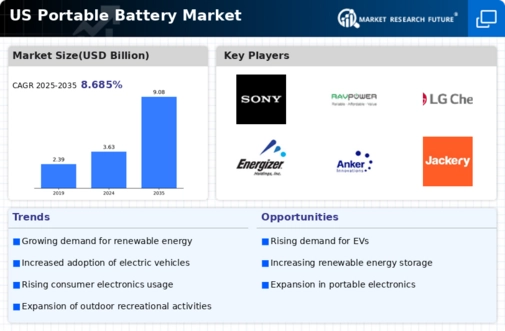The competitive landscape of the US Portable Battery Market is characterized by a rapidly evolving environment driven by technological advancements, changing consumer preferences, and increasing demand for portable power solutions. As the ubiquity of mobile devices and the internet of things (IoT) grows, the need for reliable, efficient, and durable portable batteries has surged. This market comprises established players and emerging startups, all vying for a share of a burgeoning sector. Competitive strategies often focus on innovation, product diversification, and enhancing distribution channels to effectively reach a wide array of customers.
Factors such as pricing, product performance, and brand loyalty play crucial roles in determining market competitiveness. Companies are increasingly exploring sustainability and eco-friendliness as vital attributes, thereby influencing consumer choices and brand positioning in this dynamic marketplace.
In the realm of the US Portable Battery Market, Sony stands out for its robust product offerings and strong market presence. The company has leveraged its technological prowess to develop a range of high-capacity portable batteries that cater to diverse consumer needs, including leisure, professional, and emergency usage. Sony's strengths lie in its established brand reputation, rich history in electronic innovation, and commitment to quality. With a focus on delivering superior performance and reliability, Sony has effectively positioned itself as a go-to brand for consumers seeking portable charging solutions.
Its strategic partnerships and collaborations further enhance its market reach, allowing Sony to maintain a competitive edge amid evolving market dynamics.
On the other hand, RAVPower has carved out a significant niche in the US Portable Battery Market by offering a variety of reliable and innovative charging products. The company is known for its extensive range of power banks, portable chargers, and solar chargers, which cater to tech-savvy consumers and outdoor enthusiasts alike. RAVPower emphasizes quality, efficiency, and customer satisfaction, allowing it to garner a loyal customer base. The company's strengths include its competitive pricing strategy and consistent investment in research and development, leading to the release of cutting-edge products.
Furthermore, RAVPower has engaged in strategic partnerships and collaborations to enhance its product offerings and expand market penetration. Its focus on customer feedback and the incorporation of advanced technology into product design has significantly bolstered its reputation within the US market, facilitating growth and an increased presence in the portable battery segment.






















Leave a Comment